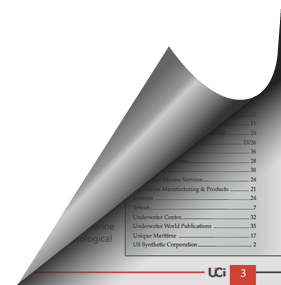
The Magazine for Underwater Professionals
![]() Jan/Feb 2019
Jan/Feb 2019
PRODUCT EYEBALL
Sailboat, submarine or both?
When is a sailboat a submarine, and when is a vessel a vehicle? When it's Ocean Aero's Submaran S10 autonomous vehicle, of course, writes Marc Deglinnocenti
A combination of wind propulsion and dive capability without crew requirements makes California, USA-based Ocean Aero’s Submaran S10 unmanned autonomous vehicle quite unique and efficient within the marine industry. An UAV that sails and dives is obviously unique, but its use of efficient free propulsion is equally clever too.
The wind is free and abundant at sea. The Submaran takes advantage of this fact just like mariners have done for thousands of years. However, the sail on this 4.14-metre long UAV is not made of cloth. It is a ridged dual composite “wingsail” that catches the wind to propel itself at five-plus knots. It can collect both surface and subsurface data while it is sailing along. All the while its solar cells are collecting more free energy from the sun. Once this UAV gets to where it wants to go, it still has fully charged batteries that take it to its next level of operation – exploring in underwater mode.
Yes, it can become a fully submerged autonomous vehicle by folding down its wingsail, starting its single propeller, and diving down under the water with its dive thrusters. How deep can it dive? The Submaran S10 can dive to an impressive 200-metre depth to collect additional and more diverse data. These impressive capabilities, along with its 23-kilogram payload, make this UAV a valuable marine data collecting device. There is always value in saving energy and having dual capabilities to complete a mission, but it also has an asset that is sometimes overlooked.
The Submaran is a weather survivable UAV. If the wind becomes too strong or the sea state becomes too rough, UAVs can be lost at sea. This one just dives down to calm subsurface waters and plods along as the storm rages above. It can hide from the waves crashing above for up to 48 hours. It can then surface after the storm passes, recharge its batteries with solar energy, and then resume its mission. Most of those missions are military in origin.
Since it can quietly sail on the surface without propeller noise and with a small radar footprint, it can sneak into enemy territory undetected. It can then dive down and detect an enemy submarine before they know what happened. It can detect enemy mines too and communicate its findings to the surface. This all-weather stealth UAV with virtually unlimited range has generated more than free energy. It has generated a great deal of interest from American defence contractor Lockheed Martin.
Lockheed Martin has made the Submaran a valuable part of an integrated defence system. The Submaran’s key role is being the interface between detecting targets below the surface and communicating that information to surface and aerial assets. Those assets can be naval vessels or aircraft such as Lockheed Martin’s Joint Strike Fighter. Not only is Lockheed Martin a customer of Ocean Aero, it is an investor as well. Lockheed Martin Ventures, Energy Innovation Capital, USA, and Teledyne Marine, USA, have all invested in this San Diego-based company. The future indeed looks bright for Ocean Aero.
The company has already sold several units. Right now each one is being hand made from scratch in about 120 days per unit. One unit is currently being tested with certain custom modifications. Once the design of this unit has been set and passed, Ocean Aero intends on switching over to an assembly line production mode. That will also prompt an order for multiple units and cut production time to less than half. The Ocean Aero Submaran S10 will soon be a standard part of allied defence systems around the world.
There is at least one non-military organisation that is also interested in the Submaran S10. That is the US National Oceanic and Atmospheric Administration (NOAA). It is interested in the Submaran’s unique ability to dive under dangerous storms yet still be close enough to them to collect valuable weather data. NOAA has even gone so far as to test the Submaran during a week-long pilot programme. No word has come back yet from NOAA though as to whether it wishes to purchase these UAVs.
Ocean Aero would be happy to sell these UAVs for just under US$300,000 (£235,000) each as a base price. Their unique multi-functionalities, unique utilisation of various free energy sources, along with their all-weather capabilities, make these UAVs valuable military and weather sampling assets. We can only wonder what is coming up next from this San Diego start-up.


